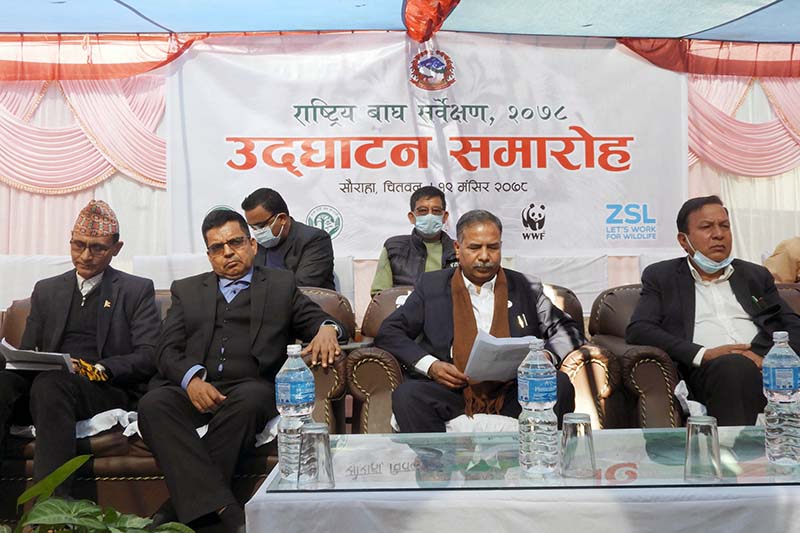
CHITWAN: Minister for Forests and Environment Ramsahay Prasad Yadav has said poaching has posed a major challenge in the conservation of tigers in Nepal.
He said this while addressing the inauguration programme of the National Tiger Survey 2021 here today.
The Forests and Environment Minister mentioned shrinking tiger habitat, declining prey population and poaching of tigers for bone and hide as the causes of decline in the population of big cats.
"Poaching along with inter-country illegal trade in wildlife parts are the challenges in preservation of tiger," he said, adding that the other problems include the construction of physical infrastructures as roads and railway tracks, among others encroaching upon the tiger's habitat.
Stating the government has attached special priority to tiger conservation, Minister Yadav called for the collaborative efforts of all including conservationists, local levels, community forest management groups and the civil society to that end.
He shared on the occasion that 90% of tiger habitat has been destroyed in the last 100 years and habitat protection is of paramount importance when it comes to tiger conservation. Noting that the tiger has made an unmatched contribution to the promotion of eco-tourism in the country, Minister Yadav underlined operating programmes so as to take the benefits of tiger conservation to the maximum of communities.
The Minister also directed the Department of National Parks and Wildlife Conservation (DNPWC) to work jointly with other bodies for managing the human-wildlife conflict. He also maintained that a work procedure on the construction of wildlife-friendly structures inside the protected areas and the wildlife corridors has been prepared and it was in the process of approval.
Stating that today was also World Soil Day, the Minister for Forests and Environment said soil is the basis of every living being and all living things on soil were part of the same ecosystem.
Ministry Secretary Pem Narayan Kandel said the number of tigers is estimated to have increased. He guessed the number of tigers would cross 250 based on the estimation by experts.
Stating the tiger habitat has been expanded in recent years, he said Banke National Park has been established and the area of Parsa Park has been expanded. He added that along with these measures, the Ministry was at work to increase the tiger population in an institutional manner.
Director General at DNPWC, Ram Chandra Kandel said wildlife conservation is facing challenges in terms of failure to effectively implement the related Acts and Regulations.
Director General of the Department of Forests and Soil Conservation, Man Bahadur Khadka, opined that conserving the tiger was not an easy job and it needed concerted and collaborative efforts from all the stakeholders.
Chief District Officer of Nawalparasi Susta Purba, Maya Pangeni, member secretary of National Trust for Nature Conservation (NTNC) Sharad Chandra Adhikari, national representative of World Wildlife Fund (WWF), Dr Ghanashyam Gurung, ZSL Nepal chief Dr Hem Sagar Baral, Chitwan National Park (CNP) chief conservation officer Shree Bhadra Acharya shed light on the importance of the tiger survey and on its various aspects.
On the occasion, Minister Yadav declared the National Tiger Survey 2021 inaugurated by operating the automatic cameras installed at two places to capture the images of tigers.
With this, the National Tiger Survey officially began today at the five national parks which provide habitat for the tiger.
Chitwan National Park (CNP)'s chief conservation officer Haribhadra Acharya said the tiger census will be conducted throughout the country by dividing the national parks providing habitat for tigers into three complexes.
According to him, Parsa National Park and CNP fall in the first complex and the survey would be conducted in this complex in 20 days. He said camera trapping would be used for counting the tigers up to Sarlahi as well since tigers have been found in the national forest areas outside of the national park and its buffer zone.
Acharya shared that two cameras will be placed at a vantage point in course of the tiger survey so as to ensure the counting. The distance between a pair of cameras would be from eight to 16 metres and both cameras would simultaneously capture the image of the same tiger.
Similarly, the distance between a pair of cameras with the next pair would be one kilometre to two kilometres. The cameras would be placed at a height of 45 to 60 centimetres from the ground.
Acharya said they would start counting the prey population after the results of the tiger survey are published.
The previous 2018 tiger census put the population of adult tigers at 235. The highest number (93) was counted in the CNP followed by 87 in Bardiya, 21 in Banke, 18 in Parsa and 16 in Shuklaphanta. This figure is expected to rise over the course of time.
The 2010 Global Conference participated by 13 countries (where tigers are found) held in St Petersburg, Russia, had pledged to double the population of tigers by 2022 and Nepal also vowed to increase its number from 121 to 250.
Tiger conservationists are hopeful that Nepal would live up to its promise to double the tigers’ population by the given time. Nepal conducts the tiger census every four years.
Source: RSS
READ ALSO:
Published Date: December 5, 2021, 12:00 am
Post Comment
E-Magazine

Click Here To Read Full Issue
RELATED B360 National






